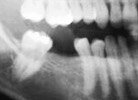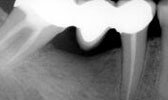Missing Tooth Replacement
Missing Lower Molars
This image shows a less severe case where the space hasn’t collapsed that much yet.
One of the most common yet severe problems we see in our office is the result of missing lower molars. Often these teeth were lost when a patient was in their teens or earlier.
If the space is left, slowly the whole bite collapses. It happens over decades, and the patient usually doesn’t notice much of a problem until the situation is very advanced. Fixing this can be complex at this stage.
Example of more severe collapse. Notice how the back teeth have tipped in. They will probably be lost in the next few years. The patient is down to about 40% chewing ability. On the right side, you can see how the top teeth have drifted down into the space. As this progresses it becomes increasingly difficult or impossible to put new teeth below them.
Untreated, it often ends up leading to the loss of all the back teeth involved, which may leave the patient with difficulty eating, headaches and jaw joint problems, and an aged appearance.
Replacing the teeth earlier is a much easier way to restore the function and appearance of natural, healthy teeth.
You can see on the left slide, these teeth had tipped severely over many years. Even in this tricky situation, we can still restore the teeth. The middle slide shows how the same teeth are being straightened orthodontically with braces to reverse the problem. We will now be able to replace these missing teeth very nicely. The right slide displays how the missing teeth have been replaced with one alternative - an implant. This patient’s mouth is almost like she was 30 years ago!
The good news: We have several solutions to solve the problem. These days we have lots of excellent options, from the traditional to new, high tech solutions.
Dental Implants
These are artificial teeth on titanium roots. They can be placed in almost every situation for most patients, and have a very high success rate. They are extremely long-lasting, seem to be resistant to gum disease, and never decay. There are certain patients or situations where implants cannot be placed though, and other solutions need to be used. (The back two molars are the implants!)
Implants can have fabulous esthetics. Here is another view of a completed implant. Can you tell which is the implant, and which is the natural tooth? The tooth in the middle is the artificial one. Visit the Dental Implants page for more information!
Fixed Bridges
These are 2 or more crowns adjacent to the space with replacement teeth attached between them. They are permanently cemented to the teeth. They feel and look very natural.
The adjacent teeth have to be reduced a bit. If they are heavily filled and need crowning anyway, this is an excellent solution because it reinforces the teeth. If the teeth around the space are perfect or they are too weak to hold a bridge, implants may be a better solution.
Bridges and crowns are among the longest lasting conventional dentistry we can do, other than implants.
You can see how natural the bridge looks. The artificial tooth in the middle can be cleaned underneath.
You should know...any time we have to do crowns, onlays or other major work on teeth that are heavily filled, sometimes the nerve may need to be treated. The chances are highest on teeth that are already in poor health with a history of past large decay.
Removable Solutions
In cases when all the teeth are missing, a denture replacement is needed.
We recommend Implants to lock down the denture. Lower dentures are especially prone to moving, but once locked down with mini-implants they are very secure.
Dr. Ehrlich can do this procedure in this office in one fairly easy appointment. It does not involve any surgical cutting of gums, just direct implant placement.
If no fixed replacement for a missing tooth is planned in the near future, we can make a small spacer to hold the space and prevent tipping and other problems. It only needs to be worn one night a week, until the permanent replacement is done.
Please visit the Ontario Dental Association website for more information:













